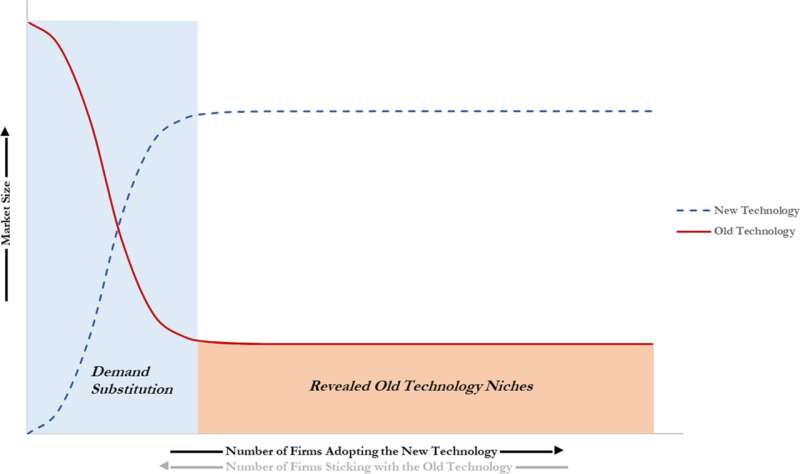This article has been reviewed according to Science X's editorial process and policies. Editors have highlighted the following attributes while ensuring the content's credibility:
fact-checked
peer-reviewed publication
proofread
When sticking with old technology can be a strategic move

Technological innovation—especially disruptive innovation—is often heralded as the best strategy for a company. But new research published in Strategic Management Journal found that as competitors adopt new technology in some markets, firms that stick with the old technology may experience an initial decline before actually rebounding and even reaching new heights.
While the rise of a discontinuous technology does pose a substitute threat to the old technology, it also further exposes niche segments where companies can gain a foothold with customers who favor the old technology.
The analysis by Xu Li, a professor at the London School of Economics and Political Science, used archival data from the traditional Chinese medicine industry in China during the 1990s. In his interviews with managers in the field, he found that some chose not to innovate along with their competitors. In many cases, Li found these companies were performing well, if not sometimes better, by not making changes. Inspired by these conversations, Li chose to study under what conditions a firm may benefit from not innovating.
Li found some prior research on why companies would stick with older technology, but none explored why—during times of disruptive change in the market—sometimes firms are able to survive and even perform better within a small niche with old technology. What Li's paper showed was that adhering to the old technology can, in some cases, be an effective strategy that ultimately improves firm performance.
The data showed a U-curve effect for traditional Chinese medicine firms that chose not to adopt new technology: The decline in performance began as a few competitors started launching a new technology, but later recovered and reached new heights as most competitors had adopted the new technology and exited the old technology market. But a lack of competition within the niche group of consumers who prefer older technology essentially gave these firms a monopoly within a smaller market as fewer competitors remained.
"Even though the new technology is often superior in terms of functionality, it doesn't mean that every single customer or customer segment will be willing to move to the new technology," Li says. "It's important to understand what customers like about your product. We tend to assume that if a firm introduces something new, then customers must appreciate the new thing or the newness of the offering. But that's not always true. The emergence of new technology can actually reveal people's preference for something older."
The research also refutes the idea that when the market is small, a company won't perform better—but that depends on how many firms are still serving this niche. If only a few firms are left to serve this market, a company has far more power to charge higher prices among loyal customers with few other options.
"When you see a firm that is not actively innovating, we tend to believe the firm must be either incapable or is suffering—it's always a bit of a negative tone," Li says. "Sometimes staying with old technology might actually be a strategic choice, because by doing so it might also lead to better performance."
More information: Xu Li, When firms may benefit from sticking with an old technology, Strategic Management Journal (2023). DOI: 10.1002/smj.3551





















